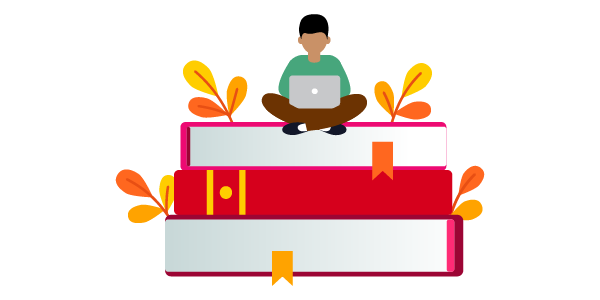Authors: Lorelei Anselmo, Patrick Kelly, Lin Yu, and Haboun Bair
Innovative course design enhances student engagement and learning by instructors intentionally thinking about how to motivate students, promote interaction and assess student learning (Mintz, 2021).
This resource summarizes three innovative course designs that can be used in your blended, face-to-face or online courses to enhance the student learning experience while supporting students to achieve course learner outcomes.
Related content
Incorporating Universal Design for Learning in Disciplinary Contexts in Higher Education
Learning Module: Adaptable Course Design

Backward course design
“Our lessons, units, and courses should be logically inferred from the results sought, not derived from the methods, books, and activities with which we are most comfortable. Curriculum should lay out the most effective ways of achieving specific results… in short, the best designs derive backward from the learnings sought” (Wiggins & McTighe as cited in Bowens, 2017).
What is it?
Backward design begins by clearly articulating the learning outcomes and goals you want your students to achieve then creates the foundations for the learning experience and assessment. The backward design approach asks instructors to consider the learning goals of the course first to highlight the knowledge and skills instructors want their students to have learned when they leave the course.
Backward design provides a framework for developing student-centered courses that ensure learning of core concepts and skills. Bowen (2017) discusses some benefits of backward design including:
-
encouraging intentionality during the design process
-
promoting transparent and explicit instruction
-
aligning each activity and assessment with the overarching goals of the course.
Consider the following guiding questions when reflecting on a backward course design:
-
How do the big ideas and essential questions of your course align with the assessments and teaching and learning activities?
-
Which knowledge and skills are necessary to achieve the learning outcomes of the course?
-
How will students demonstrate their understanding of the content and apply the knowledge and skills that they’ve learned?
Consider Wiggin and McTighe’s (1998) following steps and guiding questions when designing a course with backward design in mind:
Step 1: Identify the desired results
-
Which knowledge and skills should students be familiar with?
-
Which knowledge and skills should students have a deeper understanding of?
-
Which big ideas and important understandings should students retain?
Step 2: Determine acceptable evidence
-
How will you know if students have achieved the desired results?
-
What would be considered as acceptable evidence of student understanding and proficiency?
Step 3: Plan learning experiences and instruction
-
What knowledge and skills will students need in order to perform effectively and achieve the desired results?
-
Which activities will equip students with the needed knowledge and skills
-
Which materials and resources are best suited to accomplish these goals?
Backward design can be used in a blended, face-to-face or online course when creating new courses or revising existing courses. Using a backward design process that intentionally aligns course outcomes, assessments, and teaching and learning strategies helps map out the key ideas of the course.
Consider the following guiding questions when using the backward design as a method to align the course learning outcomes with assessments and learning activities:
-
What do I want students to know?
-
How will I know they have learned it?
-
What techniques/resources will I use to share information?
Iowa State University. (n.d.). Revised Bloom’s Taxonomy. https://www.celt.iastate.edu/teaching/effective-teaching-practices/revised-blooms-taxonomy/
Upstate University of South Carolina. (n.d.). About Backward Course Design. https://www.uscupstate.edu/faculty-staff/center-for-academic-innovation-and-faculty-support/resources-for-innovative-course-design/about-backward-course-design/
Western University. (n.d.). Backward Course Design. https://teaching.uwo.ca/curriculum/coursedesign/backward-design.html
Bowen, R.S. (2017). Understanding by design. Vanderbilt University Center for Teaching. https://cft.vanderbilt.edu/guides-sub-pages/understanding-by-design/#benefits
Mintz, S. (2021, February 8). 7 Innovative Approaches to Course Design. Inside HigherEd. https://www.insidehighered.com/blogs/higher-ed-gamma/7-innovative-approaches-course-design
Wiggins, G., & McTighe, J. (1998). Backward Design. In Understanding by Design (pp. 13-34). ASCD.
https://taylorinstitute.ucalgary.ca/learning-and-instructional-design/course-design

Inclusive course design
“Inclusive education allows…people to discover the humanity in others, and not to fear difference” (Richler, 2015).
What is it?
Inclusive course design integrates inclusivity strategies to help foster a learning environment and culture that values diverse perspectives, identities, and experiences of the individual to create a cohesive and global student learning community.
Dewsbury and Brame (2019) suggest that using an inclusive course design strategy in your teaching practice can begin transforming your classroom culture by:
-
Establishing a sense of belonging where students and instructors feel safe, respected, and valued
-
Respecting and supporting diversity in the classroom
-
Examining personal biases that impact decisions and behaviour
-
Bridging awareness with action to establish a lens of inclusion
An inclusive course design strategy is most beneficial when used before, during, and after the course design and teaching and learning process.
To determine where to begin, consider the following reflective questions:
-
What does it look like to be “knowledgeable” in your field? Where does that perception come from?
-
By what methods and activities do students learn? How did you come to know this?
-
What is your teaching philosophy and how does that influence the teaching and learning strategies you use?
-
What is your positionality? How does it inform your teaching and learning practice?
-
What do you assume students should be able to understand or do in order to be “successful” in your class?
Inclusive course design practices and strategies can help you examine and plan for a positive learning environment. Consider three inclusive practices and the strategies below:
Ensure multiple identities and communities are represented and respected as legitimate sources of critique or knowledge
-
Show students they are respected and seen by learning and using student names and personal pronouns.
-
Show students your commitment to cultivating curiosity by incorporating diverse course learning materials, a diversity statement into your course outline, and opportunities for dialogue.
Sharing power in the classroom
-
Show students your interest in knowing them by surveying their expectations and goals for the course.
-
Show students you value their ideas by facilitating consensus decision making in the classroom and co-constructing rules of engagement.
-
Show students that information is power by clarifying class expectations, showing examples, and creating opportunities for growth through regular feedback.
Designing a variety of course assessments
-
Include course learning outcomes that intentionally connect student assessments to inclusive practices such as:
- By the end of the course, students’ will be able to:
-
Study and internalize the diverse perspectives and lived experiences of literary characters who do not cater towards one type of representation
-
Critically reflect on how the role of peer learning helps deepen relationships with other literary characters and inform your own process in character building and performance
-
See how UCalgary instructor Heather Cant’s inclusive learning activity incorporates the above learning outcomes here.
Fouzia Usman, Educational Development Consultant at the Taylor Institute for Teaching and Learning, describes an inclusive learning classroom as a place that ensures dignity and respect for every human being. By incorporating inclusive design strategies into your course, the entire learning community can aspire to reach beyond their classroom and create a more inclusive world (personal communication, November 19, 2021).
Taylor Institute resources
- Teaching Philosophies and Teaching Dossiers Guide Including Leadership, Supervision, Mentorship, and EDI
- Commitment to Equity, Diversity, and Inclusion
- Moving beyond celebrating diversity towards an towards anti-racist teaching
- Incorporating Universal Design in Disciplinary Contexts in Higher Education
Supplemental resources
- Diversity Statements
- Course Design Equity and Inclusion Rubric
- Inclusive Course Design
- Inclusive Design and Design Justice: Strategies to Shape our Classes and Communities
- Inclusion by Design: Surveying your syllabus and course design
- Inclusive Instructional Design: Applying UDL to Online Learning
Additional resources
The Derek Bok Center for Teaching and Learning. (n.d.). Inclusive Course Design. https://bokcenter.harvard.edu/inclusive-course-design.
Centre for Teaching, Learning and Technology. (n.d.). Inclusive Course Design. https://ctlt-inclusiveteaching.sites.olt.ubc.ca/files/2019/01/Inclusive-Course-Design_w.pdf
Fuentes, M.A., Zelaya, D.G., & Madsen, J.W. (2021). Rethinking the course syllabus: considerations for promoting equity, diversity, and inclusion. Teaching of Psychology, 48(1). 69-79.
Dewsbury, B., & Brame, J.C. (2019). Inclusive Teaching. CBE—Life Sciences Education, 18(2), https://www.lifescied.org/doi/pdf/10.1187/cbe.19-01-0021
Richler, D. (2015, October 23). Inclusive teaching programmes: Let's develop it together!" The Convention on the Rights of Persons with Disabilities and the Sustainable Development Goals: An impetus for Inclusion. https://inclusion-international.org/wp-content/uploads/2015/11/diane-richler-salzburg-2015.pdf

Learner-centered course design
“The design of learner-centered instruction requires a paradigm shift, challenging our beliefs about learning and the role the instructor plays in the process” (Huba & Freed, 2000).
What is it?
Learner-centered course design means placing students or learners at the center of the learning process. Instead of planning what needs to be taught with the course content and topics, learner-centered course design shifts extensive attention to the needs, interests, and skills of the learners and focuses on what needs to be learned.
The heart of the learner-centered approach is to decide first what students can and should learn from the course, then how to assess the learning outcomes and finally determine how to support students in the learning process to achieve the course outcomes.
Using a learner-centered course design creates a positive student learning experience by:
-
creating learning tasks that have a real-world application that allows learners to connect personally with their learning.
-
Improving student learning by linking the student’s own experiences and prior knowledge with new learning.
-
ensuring the learning experience is meaningful and intentional through purposeful selection of content, assignments and learning activities that allow students to meet the learning course outcomes.
-
cultivating students to be self-directed learners with multiple opportunities for students to connect, collaborate, and communicate with each other throughout the course.
Consider the following guiding questions when reflecting on a learner-centered course design:
-
What type of content do students need from the instructor to progress?
-
Which activities provide students with opportunities to practice their learning?
-
Which kinds of assessments will allow students to demonstrate their learning?
1. Shift from teaching to learning:
-
A learner-centered approach puts the student perspective at the front of course design.
-
Learner-centered learners are active in questioning, analyzing, discussing, drawing conclusions, and solving problems throughout the course.
-
Instructors facilitate and support the learning process through student-centered content, activities, and assessments.
2. Get to know your learners:
-
All learners are different. Understanding the diversity of learners can make a huge difference in crafting meaningful learning experiences.
-
A learner analysis will provide you with the information to target students for additional support and to learn the strengths of individual students.
3. Revisit the learning outcomes:
-
Think about the course content in terms of what the students will be able to do, the tasks they must undertake, and the tools they can use to deal with those tasks.
-
Ensure the learning outcomes reflect student perspectives and connect with real-world learning experiences.
4. Promote student agency and autonomy
-
Deliver the content by engaging students in constructing and creating their own meaning and learning.
-
Give students more responsibilities and autonomy to manage their own learning with their own pace and individual efforts.
Consider the following guiding questions when using learner-centered course design approach:
-
How can I discover the needs, interests, and skills of my learners?
-
Where can I create opportunities for students to express their voice and choice in how they learn?
Use the learner-centered course design when you wish to shift the focus of your course design from the instructor to the learners.
Weimer (2013) suggests beginning with a learning activity or assignment where the agency is on the student. Consider the following student-driven activities:
-
Course goal setting: Ask students to create a list of additional course learning goals. The most commonly selected goals can then be added to the course syllabus.
-
Assignment choice: Choose an assignment that students can redesign to include several options of possible topics and format choices.
-
Assessment criteria: Involve students in setting the criteria that will be used to assess an assignment or activity. Use their feedback to create a set of criteria for their next assessment.
-
Quiz collaboration: At the end of an in-class quiz, give students a few minutes to discuss their answers. Allow the students to change their answers, but first add a star beside any answer they changed, then note their original answer. After the text has been marked, check back with the students about whether consulting with their peers helped or hurt their score.
-
An exam review session: Plan a review session where students are conducting the review by preparing study guides, writing possible test questions, and identifying difficult topics that require further explanation.
-
Classroom climate: To help establish a climate for learning, facilitate a discussion of next and worst class experiences. Post them for the class to see. The goal is to get students thinking about which experiences helped and which challenged their efforts to learn.
A Comprehensive Guide for Student-Centered Course Design
Trinidad, J.E. (2019). Understanding student-centred learning in higher education.: students’ and teachers’ perceptions, challenges, and cognitive gaps. Journal of Further and Higher Education, 44(8), 1013-1023. https://doi.org/10.1080/0309877X.2019.1636214
http://cei.hkust.edu.hk/teaching-resources/learner-centered-course-design
SHIFT (n.d.). Learner-centered design: The secret of creating engaging eLearning experiences. https://www.shiftelearning.com/blog/bid/345394/4-steps-to-becoming-a-learner-centered-elearning-professional
Weimar, M. (2013). Learner-centered teaching. Five key changes to practice. (2nd ed.). John Wiley & Sons.
Huba, M. & Freed, J. (2000). Learner-centered assessment on college campuses: shifting the focus from teaching to learning. Community College Journal of Research and Practice

